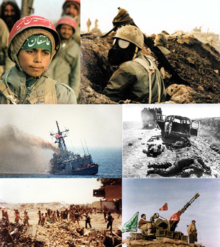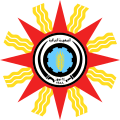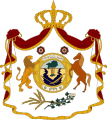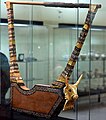Portal:Iraq
The Iraq PortalA view of Baghdad, Iraq
Iraq, officially the Republic of Iraq, is a country in West Asia and in the geopolitical region known as the Middle East. With a population of over 46 million, it is the 31st-most populous country. It is a federal parliamentary republic that consists of 19 governorates. The country is bordered by Turkey to the north, Iran to the east, the Persian Gulf and Kuwait to the southeast, Saudi Arabia to the south, Jordan to the southwest, and Syria to the west. The capital and largest city is Baghdad. The Iraqi people are diverse; mostly Arabs, as well as Kurds, Turkmen, Assyrians, Armenians, Yazidis, Mandaeans, Persians and Shabakis with similarly diverse geography and wildlife. Most Iraqis are Muslims – minority faiths include Christianity, Yazidism, Mandaeism, Yarsanism and Zoroastrianism. The official languages of Iraq are Arabic and Kurdish; others also recognized in specific regions are Turkish (Turkmen), Suret (Assyrian), and Armenian. Modern Iraq dates to 1920, when a Mandate was created by League of Nations. A British-backed monarchy was founded in 1921 under Faisal. The Hashemite kingdom gained independence from the UK in 1932. In 1958, the kingdom was overthrown and a republic was created. Iraq was ruled by the Ba'ath Party from 1968 to 2003, led by Al-Bakr and then by Saddam Hussein, as a one-party state. Iraq invaded Iran in 1980, sparking a war that ended as a stalemate in 1988. In 1990, Iraq invaded Kuwait, leading to a military campaign waged by a US-led international coalition that expelled Iraqi forces from Kuwait. An invasion launched by another US-led coalition as part of its "War on Terror" in 2003 resulted in the defeat of Ba'athists and Saddam's execution. Discontent with the de-Ba'athification policies of the Provisional Authority stirred up an anti-American insurgency, which escalated into a sectarian civil war. In 2005, a new constitution was adopted and multi-party parliamentary elections were held in Iraq. Withdrawal of US troops began in 2008, and the occupation officially ended in 2011. Continued repression and sectarian policies of Nouri al-Maliki's Shia government caused protests, after which a coalition of Ba'athist and Sunni militias took up arms during a campaign. The climax of the campaign was the North Iraq offensive by the ISID that marked its rapid territorial expansion, prompting the return of American troops to fight the war, which lasted until 2017. Iran has also intervened since 2014, expanding its influence through sectarian parties and Khomeinist militia groups, triggering widespread protests. (Full article...) Selected article -The Iran–Iraq War, also known as the First Gulf War (Arabic: حرب الخليج الأولى), was an armed conflict between Iran and Iraq that lasted from September 1980 to August 1988. Active hostilities began with the Iraqi invasion of Iran and lasted for eight years, until the acceptance of United Nations Security Council Resolution 598 by both sides. Iraq's primary rationale for the attack against Iran cited the need to prevent Ruhollah Khomeini—who had spearheaded the Iranian Revolution in 1979—from exporting the new Iranian ideology to Iraq. There were also fears among the Iraqi leadership of Saddam Hussein that Iran, a theocratic state with a population predominantly composed of Shia Muslims, would exploit sectarian tensions in Iraq by rallying Iraq's Shia majority against the Baʽathist government, which was officially secular and dominated by Sunni Muslims. Iraq also wished to replace Iran as the power player in the Persian Gulf, which was not seen as an achievable objective prior to the Islamic Revolution because of Pahlavi Iran's economic and military superiority as well as its close relationships with the United States and Israel. The Iran–Iraq War followed a long-running history of territorial border disputes between the two states, as a result of which Iraq planned to retake the eastern bank of the Shatt al-Arab that it had ceded to Iran in the 1975 Algiers Agreement. Iraqi support for Arab separatists in Iran increased following the outbreak of hostilities; Saddam disputedly may have wished to annex Iran's Arab-majority Khuzestan province. While the Iraqi leadership had hoped to take advantage of Iran's post-revolutionary chaos and expected a decisive victory in the face of a severely weakened Iran, the Iraqi military only made progress for three months, and by December 1980, the Iraqi invasion had stalled. The Iranian military began to gain momentum against the Iraqis and regained all lost territory by June 1982. After pushing Iraqi forces back to the pre-war border lines, Iran rejected United Nations Security Council Resolution 514 and launched an invasion of Iraq. The subsequent Iranian offensive within Iraqi territory lasted for five years, with Iraq taking back the initiative in mid-1988 and subsequently launching a series of major counter-offensives that ultimately led to the conclusion of the war in a stalemate. (Full article...)Selected picture The Code of Hammurabi (Codex Hammurabi), the best preserved ancient law code, was created ca. 1760 BC (middle chronology) in ancient Babylon. It was enacted by the sixth Babylonian king, Hammurabi.
Did you know...
Selected biography -Dame Zaha Mohammad Hadid DBE RA (Arabic: زها حديد Zahā Ḥadīd; 31 October 1950 – 31 March 2016) was an Iraqi-British architect, artist and designer, recognized as a major figure in architecture of the late-20th and early-21st centuries. Born in Baghdad, Iraq, Hadid studied mathematics as an undergraduate and then enrolled at the Architectural Association School of Architecture in 1972. In search of an alternative system to traditional architectural drawing, and influenced by Suprematism and the Russian avant-garde, Hadid adopted painting as a design tool and abstraction as an investigative principle to "reinvestigate the aborted and untested experiments of Modernism [...] to unveil new fields of building". She was described by The Guardian as the "Queen of Curves", who "liberated architectural geometry, giving it a whole new expressive identity". Her major works include the London Aquatics Centre for the 2012 Olympics, the Broad Art Museum, Rome's MAXXI Museum, and the Guangzhou Opera House. Some of her awards have been presented posthumously, including the statuette for the 2017 Brit Awards. With several awards and accolades to her name, she has also been recognized by the 2013 Forbes List as one of the "World's Most Powerful Women" Several of her buildings were still under construction at the time of her death, including the Daxing International Airport in Beijing, and the Al Wakrah Stadium (now Al Janoub) in Qatar, a venue for the 2022 FIFA World Cup. (Full article...)
General imagesThe following are images from various Iraq-related articles on Wikipedia.
ListsTopicsCategoriesRelated portalsReligions in Iraq Arab states WikiProjectsThings you can do
Associated WikimediaThe following Wikimedia Foundation sister projects provide more on this subject:
Discover Wikipedia using portals | ||||||||
































































